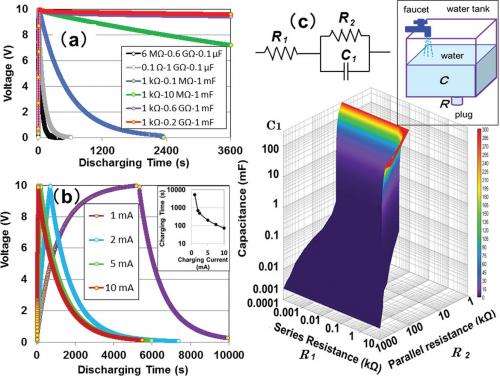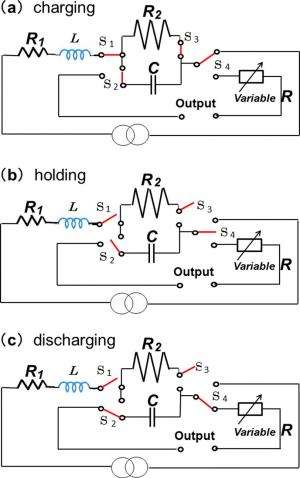(a) and (b) The charging/discharging curves for various resistor-capacitor combinations. (c) Three-dimensional funnel-shaped surface contour displaying energy-rich discharging after complete charging. Credit: Fukuhara, et al. ©2014 AIP Publishing LLC
(Phys.org)—Capacitors are widely used in electrical circuits to store small amounts of energy, but have never been used for large-scale energy storage. Now researchers from Japan have shown that the right combination of resistors and capacitors can allow electrical circuits to meet two key requirements of an energy storage device: quick charging and long-term discharging. Using capacitors as energy storage devices in circuits has potential applications for hybrid electric vehicles, backup power supplies, and alternative energy storage.
The researchers, Prof. Mikio Fukuhara, Tomoyuki Kuroda, and Prof. Fumihiko Hasegawa, at Tohoku University in Sendai, Japan, have published their paper in a recent issue of Applied Physics Letters.
Developing efficient methods of electrical energy storage is a major topic of research, with a strong focus on batteries, fuel cells, and electric double-layer capacitors (EDLCs) when not incorporated in circuits. So far, no research has been performed on the use of capacitors or supercapacitors as energy storage devices in circuits.
To explore the possibility of using capacitors to store energy in circuits, the researchers investigated the charging/discharging behavior of 126 resistor-capacitor (RC) combinations of 18 resistors, three ceramic capacitors, and four aluminum capacitors. They found that the RC combinations that are the best in terms of quick charging and long-term discharging consist of circuits with a small resistor, a large resistor, and a large capacitor. Some of these circuits could be charged in less than 20 seconds and hold the charge for up to 40 minutes, while having relatively large capacitances of up to 100 milliFarads (mF).
How to quickly store a large amount of electricity and control long-term discharging in an electrical circuit: (a) The capacitor (C) is quickly charged by closing switches S1, S2, S3, and S4. (b) To store the electricity in the capacitor, switches S1, S2, S3, and S4 are then opened. (c) Long-term discharging is carried out by closing S2 and S4, which closes the output circuit, and then using the variable resistor to control the discharging. ©2014 AIP Publishing LLC
"The greatest significance of this work is the discovery of an RC region that offers quick charging and long-term discharging in an electrical circuit," Fukuhara told Phys.org. "We think that this system will become an important method for storing much energy or only small amounts of energy in the near future. For this purpose, the storage capacitor must change from an electrochemical to a physical device."
The researchers attribute the quick charging and long-term discharging to the damming effect of the large resistor in the circuit. They explain that the relationship between the resistance and the capacitance of a supercapacitor is similar to that between the plug size and the amount of water in a water tank. The larger the plug (resistor), the more water (capacitance) the tank can hold. Until now, the damming effect of this RC combination on electrical energy storage in such circuits has been overlooked.
The results also showed that a "dry" or "solid" supercapacitor made of an amorphous TiO2 surface with nanometer-sized cavities provides better performance than typical supercapacitors that use liquid solvents. The researchers' earlier work on these dry TiO2 capacitors showed that they have several advantages for energy storage, such as a large capacitance of 4.8 F, wide operating temperature range from 193 to 453 K, and large voltage variation from 10 to 150 V. In contrast, traditional EDLCs suffer limitations in all of these areas.
"Besides the early original researchers of electric circuits, people have believed that circuits are used only for quick charging and prompt discharging," Fukuhara said. "Consequently, the damming effect of this RC combination on electrical energy storage in such circuits has been overlooked. When we began researching the dry physical capacitance using solid materials only, we began questioning the usual usage of capacitors based on the conventional concept."
In the future, the researchers plan to work on further improving the performance of these dry supercapacitors in order to make improvements to the energy-storage system overall.
"Our plans are to develop dry, physical electric storage devices for use by electric vehicles, AC transmission lines, and charging of large amounts of lightning or large amounts of currents stored in air," Fukuhara said. "However, it will take a long time."
More information: Mikio Fukuhara, et al. "Realizing a supercapacitor in an electrical circuit." Applied Physics Letters. DOI: 10.1063/1.4902410
Journal information: Applied Physics Letters
© 2014 Phys.org























